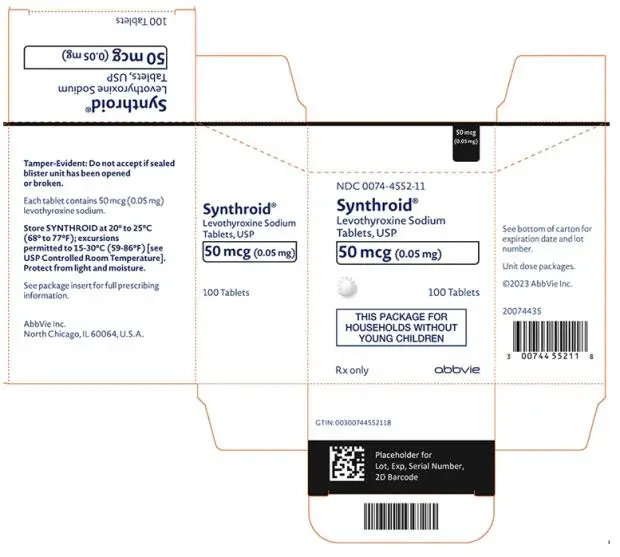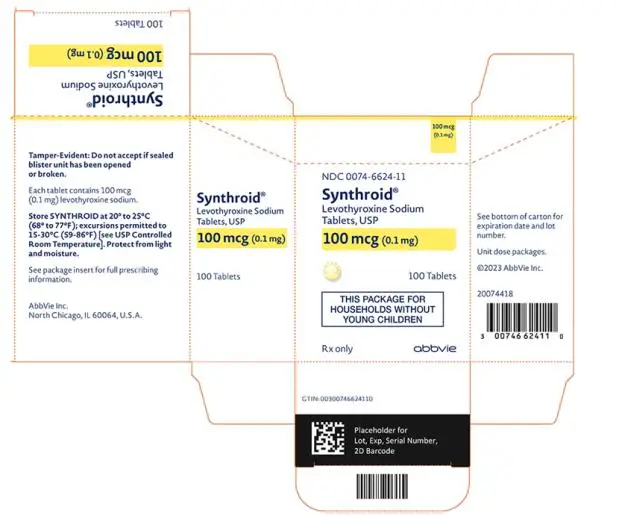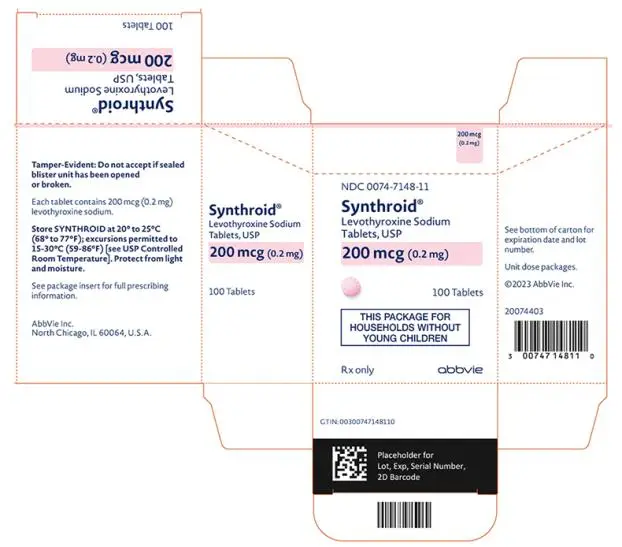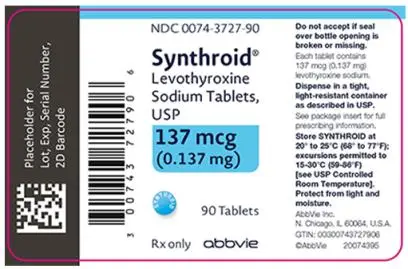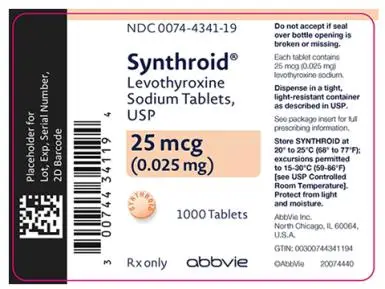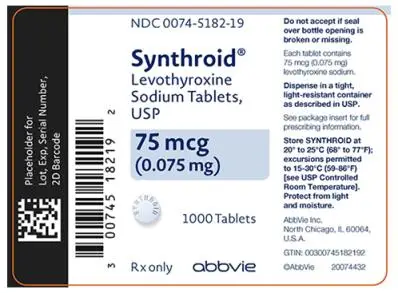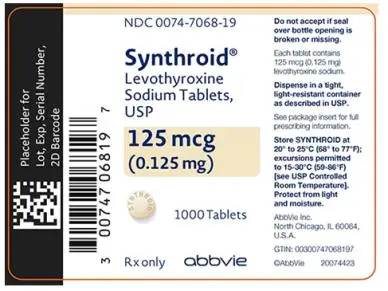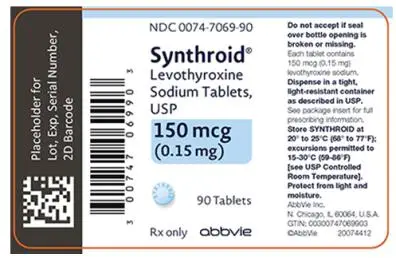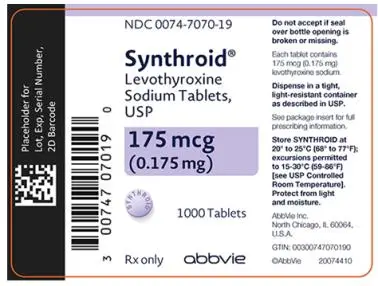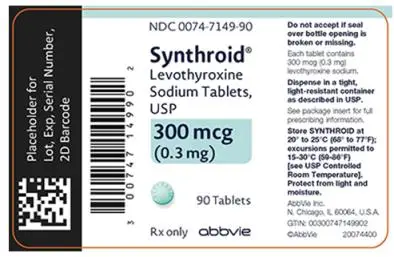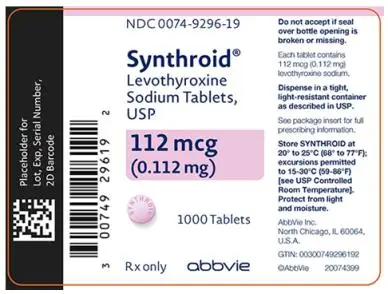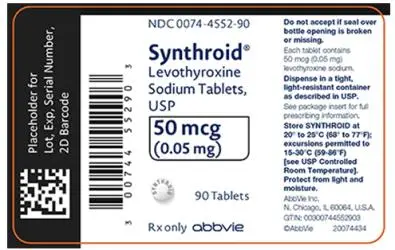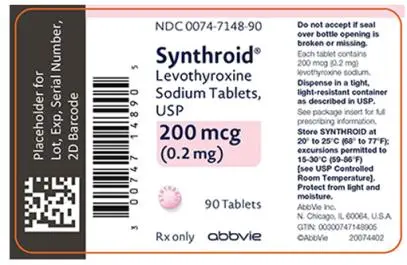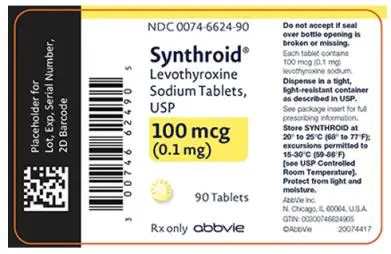Drug Detail:Synthroid (Levothyroxine [ lee-voe-thye-rox-een ])
Drug Class: Thyroid drugs
Highlights of Prescribing Information
SYNTHROID® (levothyroxine sodium) tablets, for oral use
Initial U.S. Approval: 2002
WARNING: NOT FOR TREATMENT OF OBESITY OR FOR WEIGHT LOSS
See full prescribing information for complete boxed warning
-
Thyroid hormones, including SYNTHROID, should not be used for the treatment of obesity or for weight loss.
- Doses beyond the range of daily hormonal requirements may produce serious or even life-threatening manifestations of toxicity (6, 10).
Recent Major Changes
| Indications and Usage (1) | 8/2022 |
| Dosage and Administration (2.2) | 8/2022 |
| Dosage and Administration (2.3) | 10/2022 |
| Dosage and Administration (2.4) | 10/2022 |
| Warnings and Precautions (5.1) | 8/2022 |
| Warnings and Precautions (5.4) | 8/2022 |
Indications and Usage for Synthroid
SYNTHROID is a L-thyroxine (T4) indicated in adult and pediatric patients, including neonates, for:
- Hypothyroidism: As replacement therapy in primary (thyroidal), secondary (pituitary), and tertiary (hypothalamic) congenital or acquired hypothyroidism. (1)
- Pituitary Thyrotropin (Thyroid-Stimulating Hormone, TSH) Suppression: As an adjunct to surgery and radioiodine therapy in the management of thyrotropin-dependent well-differentiated thyroid cancer. (1)
Limitations of Use:
- Not indicated for suppression of benign thyroid nodules and nontoxic diffuse goiter in iodine-sufficient patients
- Not indicated for treatment of hypothyroidism during the recovery phase of subacute thyroiditis
Synthroid Dosage and Administration
- Administer once daily, preferably on an empty stomach, one-half to one hour before breakfast. (2.1)
- Administer at least 4 hours before or after drugs that are known to interfere with absorption. (2.1)
- Evaluate the need for dose adjustments when regularly administering within one hour of certain foods that may affect absorption. (2.1)
- Starting dose depends on a variety of factors, including age, body weight, cardiovascular status, and concomitant medications. Peak therapeutic effect may not be attained for 4-6 weeks. (2.2)
- See full prescribing information for dosing in specific patient populations. (2.3)
- Adequacy of therapy determined with periodic monitoring of TSH and/or T4 as well as clinical status. (2.4)
Dosage Forms and Strengths
Tablets: 25, 50, 75, 88, 100, 112, 125, 137, 150, 175, 200, and 300 mcg (3)
Contraindications
- Uncorrected adrenal insufficiency. (4)
Warnings and Precautions
-
Serious risks related to overtreatment or undertreatment with SYNTHROID: Titrate the dose of SYNTHROID carefully and monitor response to titration. (5.1)
-
Cardiac adverse reactions in the elderly and in patients with underlying cardiovascular disease: Initiate SYNTHROID at less than the full replacement dose because of the increased risk of cardiac adverse reactions, including atrial fibrillation. (2.3, 5.2, 8.5)
-
Myxedema coma: Do not use oral thyroid hormone drug products to treat myxedema coma. (5.3)
-
Acute adrenal crisis in patients with concomitant adrenal insufficiency: Treat with replacement glucocorticoids prior to initiation of SYNTHROID treatment. (5.4)
-
Worsening of diabetic control: Therapy in patients with diabetes mellitus may worsen glycemic control and result in increased antidiabetic agent or insulin requirements. Carefully monitor glycemic control after starting, changing, or discontinuing thyroid hormone therapy. (5.5)
- Decreased bone mineral density associated with thyroid hormone over-replacement: Over-replacement can increase bone resorption and decrease bone mineral density. Give the lowest effective dose. (5.6)
Adverse Reactions/Side Effects
Adverse reactions associated with SYNTHROID therapy are primarily those of hyperthyroidism due to therapeutic overdosage: arrhythmias, myocardial infarction, dyspnea, muscle spasm, headache, nervousness, irritability, insomnia, tremors, muscle weakness, increased appetite, weight loss, diarrhea, heat intolerance, menstrual irregularities, and skin rash. (6)
To report SUSPECTED ADVERSE REACTIONS, contact AbbVie Inc. at 1-800-633-9110 or FDA at 1-800-FDA-1088 or www.fda.gov/medwatch.
Drug Interactions
See full prescribing information for drugs that affect thyroid hormone pharmacokinetics and metabolism (e.g., absorption, synthesis, secretion, catabolism, protein binding, and target tissue response) and may alter the therapeutic response to SYNTHROID. (7)
Use In Specific Populations
Pregnancy may require the use of higher doses of SYNTHROID. (2.3, 8.1)
See 17 for PATIENT COUNSELING INFORMATION.
Revised: 10/2022
Related/similar drugs
levothyroxine, Euthyrox, liothyronine, Armour Thyroid, Levoxyl, Tirosint, CytomelFull Prescribing Information
1. Indications and Usage for Synthroid
Hypothyroidism
SYNTHROID is indicated in adult and pediatric patients, including neonates, as a replacement therapy in primary (thyroidal), secondary (pituitary), and tertiary (hypothalamic) congenital or acquired hypothyroidism.
Pituitary Thyrotropin (Thyroid-Stimulating Hormone, TSH) Suppression
SYNTHROID is indicated in adult and pediatric patients, including neonates, as an adjunct to surgery and radioiodine therapy in the management of thyrotropin-dependent well-differentiated thyroid cancer.
Limitations of Use
- SYNTHROID is not indicated for suppression of benign thyroid nodules and nontoxic diffuse goiter in iodine-sufficient patients as there are no clinical benefits and overtreatment with SYNTHROID may induce hyperthyroidism [see Warnings and Precautions (5.1)].
- SYNTHROID is not indicated for treatment of hypothyroidism during the recovery phase of subacute thyroiditis.
2. Synthroid Dosage and Administration
2.1 Important Administration Instructions
Administer SYNTHROID as a single daily dose, on an empty stomach, one-half to one hour before breakfast.
Administer SYNTHROID at least 4 hours before or after drugs known to interfere with SYNTHROID absorption [see Drug Interactions (7.1)].
Evaluate the need for dosage adjustments when regularly administering within one hour of certain foods that may affect SYNTHROID absorption [see Dosage and Administration (2.2 and 2.3), Drug Interactions (7.9) and Clinical Pharmacology (12.3)].
Administer SYNTHROID to pediatric patients who cannot swallow intact tablets by crushing the tablet, suspending the freshly crushed tablet in a small amount (5 to 10 mL) of water and immediately administering the suspension by spoon or dropper. Ensure the patient ingests the full amount of the suspension. Do not store the suspension. Do not administer in foods that decrease absorption of SYNTHROID, such as soybean-based infant formula [see Drug Interactions (7.9)].
2.2 Important Considerations for Dosing
The dosage of SYNTHROID for hypothyroidism or pituitary TSH suppression depends on a variety of factors including: the patient's age, body weight, cardiovascular status, concomitant medical conditions (including pregnancy), concomitant medications, co-administered food and the specific nature of the condition being treated [see Dosage and Administration (2.3), Warnings and Precautions (5), and Drug Interactions (7)]. Dosing must be individualized to account for these factors and dosage adjustments made based on periodic assessment of the patient's clinical response and laboratory parameters [see Dosage and Administration (2.4)].
For adult patients with primary hypothyroidism, titrate until the patient is clinically euthyroid and the serum TSH returns to normal [see Dosage and Administration (2.3)].
For secondary or tertiary hypothyroidism, serum TSH is not a reliable measure of SYNTHROID dosage adequacy and should not be used to monitor therapy. Use the serum free-T4 level to titrate SYNTHROID dosing until the patient is clinically euthyroid and the serum free-T4 level is restored to the upper half of the normal range [see Dosage and Administration (2.3)].
The peak therapeutic effect of a given dose of SYNTHROID may not be attained for 4 to 6 weeks.
2.3 Recommended Dosage and Titration
Primary, Secondary, and Tertiary Hypothyroidism in Adults
The recommended starting daily dosage of SYNTHROID in adults with primary, secondary, or tertiary hypothyroidism is based on age and comorbid cardiac conditions, as described in Table 1. For patients at risk of atrial fibrillation or patients with underlying cardiac disease, start with a lower dosage and titrate the dosage more slowly to avoid exacerbation of cardiac symptoms. Dosage titration is based on serum TSH or free-T4 [see Dosage and Administration (2.2)].
| Patient Population | Starting Dosage | Dosage Titration Based on Serum TSH or Free-T4 |
| Adults diagnosed with hypothyroidism | Full replacement dose is 1.6 mcg/kg/day. Some patients require a lower starting dose. | Titrate dosage by 12.5 to 25 mcg increments every 4 to 6 weeks, as needed until the patient is euthyroid. |
| Adults at risk for atrial fibrillation or with underlying cardiac disease | Lower starting dose (less than 1.6 mcg/kg/day) | Titrate dosage every 6 to 8 weeks, as needed until the patient is euthyroid. |
| Geriatric patients | Lower starting dose (less than 1.6 mcg/kg/day) |
* Dosages greater than 200 mcg/day are seldom required. An inadequate response to daily dosages greater than 300 mcg/day is rare and may indicate poor compliance, malabsorption, drug interactions, or a combination of these factors [see Dosage and Administration (2.1) and Drug Interactions (7)].
Primary, Secondary, and Tertiary Hypothyroidism in Pediatric Patients
The recommended starting daily dosage of SYNTHROID in pediatric patients with primary, secondary, or tertiary hypothyroidism is based on body weight and changes with age as described in Table 2. Titrate the dosage (every 2 weeks) as needed based on serum TSH or free-T4 until the patient is euthyroid [see Dosage and Administration (2.2)].
| Age | Starting Daily Dosage Per Kg Body Weight* |
| 0-3 months | 10-15 mcg/kg/day |
| 3-6 months | 8-10 mcg/kg/day |
| 6-12 months | 6-8 mcg/kg/day |
| 1-5 years | 5-6 mcg/kg/day |
| 6-12 years | 4-5 mcg/kg/day |
| Greater than 12 years but growth and puberty incomplete | 2-3 mcg/kg/day |
| Growth and puberty complete | 1.6 mcg/kg/day |
| * Adjust dosage based on clinical response and laboratory parameters [see Dosage and Administration (2.4) and Use in Specific Populations (8.4)]. | |
Pediatric Patients from Birth to 3 Months of Age at Risk for Cardiac Failure
Start at a lower starting dosage and increase the dosage every 4 to 6 weeks as needed based on clinical and laboratory response.
Pediatric Patients at Risk for Hyperactivity
To minimize the risk of hyperactivity, start at one-fourth the recommended full replacement dosage, and increase on a weekly basis by one-fourth the full recommended replacement dosage until the full recommended replacement dosage is reached.
Hypothyroidism in Pregnant Patients
For pregnant patients with pre-existing hypothyroidism, measure serum TSH and free-T4 as soon as pregnancy is confirmed and, at minimum, during each trimester of pregnancy. In pregnant patients with primary hypothyroidism, maintain serum TSH in the trimester-specific reference range.
The recommended daily dosage of SYNTHROID in pregnant patients is described in Table 3.
| Patient Population | Starting Dosage | Dose Adjustment and Titration |
| Pre-existing primary hypothyroidism with serum TSH above normal trimester-specific range | Pre-pregnancy dosage may increase during pregnancy | Increase SYNTHROID dosage by 12.5 to 25 mcg per day. Monitor TSH every 4 weeks until a stable dose is reached and serum TSH is within normal trimester-specific range. Reduce SYNTHROID dosage to pre-pregnancy levels immediately after delivery. Monitor serum TSH 4 to 8 weeks postpartum. |
| New onset hypothyroidism (TSH ≥ 10 mIU per liter) | 1.6 mcg/kg/day | Monitor serum TSH every 4 weeks and adjust SYNTHROID dosage until serum TSH is within normal trimester-specific range. |
| New onset hypothyroidism (TSH < 10 mIU per liter) | 1.0 mcg/kg/day |
TSH Suppression in Well-differentiated Thyroid Cancer in Adult and Pediatric Patients
The SYNTHROID dosage is based on the target level of TSH suppression for the stage and clinical status of thyroid cancer.
2.4 Monitoring TSH and/or Thyroxine (T4) Levels
Assess the adequacy of therapy by periodic assessment of laboratory tests and clinical evaluation. Persistent clinical and laboratory evidence of hypothyroidism despite an apparent adequate replacement dose of SYNTHROID may be evidence of inadequate absorption, poor compliance, drug interactions, or a combination of these factors.
Adults
In adult patients with primary hypothyroidism, monitor serum TSH levels after an interval of 6 to 8 weeks after any change in dosage. In patients on a stable and appropriate replacement dosage, evaluate clinical and biochemical response every 6 to 12 months and whenever there is a change in the patient’s clinical status.
Pediatric Patients
In patients with hypothyroidism, assess the adequacy of replacement therapy by measuring both serum TSH and total or free-T4. Monitor TSH and total or free-T4 in pediatric patients as follows: 2 and 4 weeks after the initiation of treatment, 2 weeks after any change in dosage, and then every 3 to 12 months thereafter following dosage stabilization until growth is completed. Poor compliance or abnormal values may necessitate more frequent monitoring. Perform routine clinical examination, including assessment of development, mental and physical growth, and bone maturation, at regular intervals.
The general aim of therapy is to normalize the serum TSH level. TSH may not normalize in some patients due to in utero hypothyroidism causing a resetting of pituitary-thyroid feedback. Failure of the serum T4 to increase into the upper half of the normal range within 2 weeks of initiation of SYNTHROID therapy and/or of the serum TSH to decrease below 20 mIU per liter within 4 weeks may indicate the patient is not receiving adequate therapy. Assess compliance, dose of medication administered, and method of administration prior to increasing the dose of SYNTHROID [see Warnings and Precautions (5.1) and Use in Specific Populations (8.4)].
Secondary and Tertiary Hypothyroidism
Monitor serum free-T4 levels and maintain in the upper half of the normal range in these patients.
3. Dosage Forms and Strengths
SYNTHROID tablets are available as follows (Table 4):
| Tablet Strength | Tablet Color/Shape | Tablet Markings |
| 25 mcg | Orange/Round | “SYNTHROID” and “25” |
| 50 mcg | White/Round | “SYNTHROID” and “50” |
| 75 mcg | Violet/Round | “SYNTHROID” and “75” |
| 88 mcg | Olive/Round | “SYNTHROID” and “88” |
| 100 mcg | Yellow/Round | “SYNTHROID” and “100” |
| 112 mcg | Rose/Round | “SYNTHROID” and “112” |
| 125 mcg | Brown/Round | “SYNTHROID” and “125” |
| 137 mcg | Turquoise/Round | “SYNTHROID” and “137” |
| 150 mcg | Blue/Round | “SYNTHROID” and “150” |
| 175 mcg | Lilac/Round | “SYNTHROID” and “175” |
| 200 mcg | Pink/Round | “SYNTHROID” and “200” |
| 300 mcg | Green/Round | “SYNTHROID” and “300” |
4. Contraindications
SYNTHROID is contraindicated in patients with uncorrected adrenal insufficiency [see Warnings and Precautions (5.4)].
5. Warnings and Precautions
5.1 Serious Risks Related to Overtreatment or Undertreatment with SYNTHROID
SYNTHROID has a narrow therapeutic index. Overtreatment or undertreatment with SYNTHROID may have negative effects on growth and development, cardiovascular function, bone metabolism, reproductive function, cognitive function, gastrointestinal function, and glucose and lipid metabolism in adult or pediatric patients.
In pediatric patients with congenital and acquired hypothyroidism, undertreatment may adversely affect cognitive development and linear growth, and overtreatment is associated with craniosynostosis and acceleration of bone age [see Use in Specific Populations (8.4)].
Titrate the dose of SYNTHROID carefully and monitor response to titration to avoid these effects [see Dosage and Administration (2.4)]. Consider the potential for food or drug interactions and adjust the administration or dosage of SYNTHROID as needed [see Dosage and Administration (2.1), Drug Interactions (7.1), and Clinical Pharmacology (12.3)].
5.2 Cardiac Adverse Reactions in the Elderly and in Patients with Underlying Cardiovascular Disease
Over-treatment with levothyroxine may cause an increase in heart rate, cardiac wall thickness, and cardiac contractility and may precipitate angina or arrhythmias, particularly in patients with cardiovascular disease and in elderly patients. Initiate SYNTHROID therapy in this population at lower doses than those recommended in younger individuals or in patients without cardiac disease [see Dosage and Administration (2.3), Use in Specific Populations (8.5)].
Monitor for cardiac arrhythmias during surgical procedures in patients with coronary artery disease receiving suppressive SYNTHROID therapy. Monitor patients receiving concomitant SYNTHROID and sympathomimetic agents for signs and symptoms of coronary insufficiency.
If cardiac symptoms develop or worsen, reduce the SYNTHROID dose or withhold for one week and restart at a lower dose.
5.3 Myxedema Coma
Myxedema coma is a life-threatening emergency characterized by poor circulation and hypometabolism and may result in unpredictable absorption of levothyroxine sodium from the gastrointestinal tract. Use of oral thyroid hormone drug products is not recommended to treat myxedema coma. Administer thyroid hormone products formulated for intravenous administration to treat myxedema coma.
5.4 Acute Adrenal Crisis in Patients with Concomitant Adrenal Insufficiency
Thyroid hormone increases metabolic clearance of glucocorticoids. Initiation of thyroid hormone therapy prior to initiating glucocorticoid therapy may precipitate an acute adrenal crisis in patients with adrenal insufficiency. Treat patients with adrenal insufficiency with replacement glucocorticoids prior to initiating treatment with SYNTHROID [see Contraindications (4)].
5.5 Worsening of Diabetic Control
Addition of levothyroxine therapy in patients with diabetes mellitus may worsen glycemic control and result in increased antidiabetic agent or insulin requirements. Carefully monitor glycemic control after starting, changing, or discontinuing SYNTHROID [see Drug Interactions (7.2)].
5.6 Decreased Bone Mineral Density Associated with Thyroid Hormone Over-Replacement
Increased bone resorption and decreased bone mineral density may occur as a result of levothyroxine over-replacement, particularly in post-menopausal women. The increased bone resorption may be associated with increased serum levels and urinary excretion of calcium and phosphorous, elevations in bone alkaline phosphatase, and suppressed serum parathyroid hormone levels. Administer the minimum dose of SYNTHROID that achieves the desired clinical and biochemical response to mitigate this risk.
6. Adverse Reactions/Side Effects
Adverse reactions associated with SYNTHROID therapy are primarily those of hyperthyroidism due to therapeutic overdosage [see Warnings and Precautions (5), Overdosage (10)]. They include the following:
-
General: fatigue, increased appetite, weight loss, heat intolerance, fever, excessive sweating
-
Central nervous system: headache, hyperactivity, nervousness, anxiety, irritability, emotional lability, insomnia
-
Musculoskeletal: tremors, muscle weakness, muscle spasm
-
Cardiovascular: palpitations, tachycardia, arrhythmias, increased pulse and blood pressure, heart failure, angina, myocardial infarction, cardiac arrest
-
Respiratory: dyspnea
-
Gastrointestinal: diarrhea, vomiting, abdominal cramps, elevations in liver function tests
-
Dermatologic: hair loss, flushing, rash
-
Endocrine: decreased bone mineral density
- Reproductive: menstrual irregularities, impaired fertility
Seizures have been reported rarely with the institution of levothyroxine therapy.
Adverse Reactions in Pediatric Patients
Pseudotumor cerebri and slipped capital femoral epiphysis have been reported in pediatric patients receiving levothyroxine therapy. Overtreatment may result in craniosynostosis in infants who have not undergone complete closure of the fontanelles, and in premature closure of the epiphyses in pediatric patients still experiencing growth with resultant compromised adult height.
Hypersensitivity Reactions
Hypersensitivity reactions to inactive ingredients have occurred in patients treated with thyroid hormone products. These include urticaria, pruritus, skin rash, flushing, angioedema, various gastrointestinal symptoms (abdominal pain, nausea, vomiting and diarrhea), fever, arthralgia, serum sickness, and wheezing. Hypersensitivity to levothyroxine itself is not known to occur.
7. Drug Interactions
7.1 Drugs Known to Affect Thyroid Hormone Pharmacokinetics
Many drugs can exert effects on thyroid hormone pharmacokinetics and metabolism (e.g., absorption, synthesis, secretion, catabolism, protein binding, and target tissue response) and may alter the therapeutic response to SYNTHROID (Tables 5 to 8).
| Potential impact: Concurrent use may reduce the efficacy of SYNTHROID by binding and delaying or preventing absorption, potentially resulting in hypothyroidism. | |
| Drug or Drug Class | Effect |
| Phosphate Binders (e.g., calcium carbonate, ferrous sulfate, sevelamer, lanthanum) | Phosphate binders may bind to levothyroxine. Administer SYNTHROID at least 4 hours apart from these agents. |
| Orlistat | Monitor patients treated concomitantly with orlistat and SYNTHROID for changes in thyroid function. |
| Bile Acid Sequestrants (e.g., colesevelam, cholestyramine, colestipol) Ion Exchange Resins (e.g., Kayexalate) | Bile acid sequestrants and ion exchange resins are known to decrease levothyroxine absorption. Administer SYNTHROID at least 4 hours prior to these drugs or monitor TSH levels. |
| Proton Pump Inhibitors Sucralfate Antacids (e.g., aluminum & magnesium hydroxides, simethicone) | Gastric acidity is an essential requirement for adequate absorption of levothyroxine. Sucralfate, antacids and proton pump inhibitors may cause hypochlorhydria, affect intragastric pH, and reduce levothyroxine absorption. Monitor patients appropriately. |
| Drug or Drug Class | Effect |
| Clofibrate Estrogen-containing oral contraceptives Estrogens (oral) Heroin / Methadone 5-Fluorouracil Mitotane Tamoxifen | These drugs may increase serum thyroxine-binding globulin (TBG) concentration. |
| Androgens / Anabolic Steroids Asparaginase Glucocorticoids Slow-Release Nicotinic Acid | These drugs may decrease serum TBG concentration. |
| Potential impact (below): Administration of these agents with SYNTHROID results in an initial transient increase in FT4. Continued administration results in a decrease in serum T4 and normal FT4 and TSH concentrations. | |
| Salicylates (> 2 g/day) | Salicylates inhibit binding of T4 and T3 to TBG and transthyretin. An initial increase in serum FT4 is followed by return of FT4 to normal levels with sustained therapeutic serum salicylate concentrations, although total T4 levels may decrease by as much as 30%. |
| Other drugs: Carbamazepine Furosemide (> 80 mg IV) Heparin Hydantoins Non-Steroidal Anti-inflammatory Drugs - Fenamates | These drugs may cause protein-binding site displacement. Furosemide has been shown to inhibit the protein binding of T4 to TBG and albumin, causing an increase free T4 fraction in serum. Furosemide competes for T4-binding sites on TBG, prealbumin, and albumin, so that a single high dose can acutely lower the total T4 level. Phenytoin and carbamazepine reduce serum protein binding of levothyroxine, and total and free T4 may be reduced by 20% to 40%, but most patients have normal serum TSH levels and are clinically euthyroid. Closely monitor thyroid hormone parameters. |
| Potential impact: Stimulation of hepatic microsomal drug-metabolizing enzyme activity may cause increased hepatic degradation of levothyroxine, resulting in increased SYNTHROID requirements. | |
| Drug or Drug Class | Effect |
| Phenobarbital Rifampin | Phenobarbital has been shown to reduce the response to thyroxine. Phenobarbital increases L-thyroxine metabolism by inducing uridine 5’-diphospho-glucuronosyltransferase (UGT) and leads to lower T4 serum levels. Changes in thyroid status may occur if barbiturates are added or withdrawn from patients being treated for hypothyroidism. Rifampin has been shown to accelerate the metabolism of levothyroxine. |
| Potential impact: Administration of these enzyme inhibitors decreases the peripheral conversion of T4 to T3, leading to decreased T3 levels. However, serum T4 levels are usually normal but may occasionally be slightly increased. | |
| Drug or Drug Class | Effect |
| Beta-adrenergic antagonists (e.g., Propranolol > 160 mg/day) | In patients treated with large doses of propranolol (> 160 mg/day), T3 and T4 levels change, TSH levels remain normal, and patients are clinically euthyroid. Actions of particular beta-adrenergic antagonists may be impaired when a hypothyroid patient is converted to the euthyroid state. |
| Glucocorticoids (e.g., Dexamethasone > 4 mg/day) | Short-term administration of large doses of glucocorticoids may decrease serum T3 concentrations by 30% with minimal change in serum T4 levels. However, long-term glucocorticoid therapy may result in slightly decreased T3 and T4 levels due to decreased TBG production (See above). |
| Other drugs: Amiodarone | Amiodarone inhibits peripheral conversion of levothyroxine (T4) to triiodothyronine (T3) and may cause isolated biochemical changes (increase in serum free-T4, and decreased or normal free-T3) in clinically euthyroid patients. |
7.2 Antidiabetic Therapy
Addition of SYNTHROID therapy in patients with diabetes mellitus may worsen glycemic control and result in increased antidiabetic agent or insulin requirements. Carefully monitor glycemic control, especially when thyroid therapy is started, changed, or discontinued [see Warnings and Precautions (5.5)].
7.7 Sympathomimetics
Concurrent use of sympathomimetics and SYNTHROID may increase the effects of sympathomimetics or thyroid hormone. Thyroid hormones may increase the risk of coronary insufficiency when sympathomimetic agents are administered to patients with coronary artery disease.
7.9 Drug-Food Interactions
Consumption of certain foods may affect SYNTHROID absorption thereby necessitating adjustments in dosing [see Dosage and Administration (2.1)]. Soybean flour, cottonseed meal, walnuts, and dietary fiber may bind and decrease the absorption of SYNTHROID from the gastrointestinal tract. Grapefruit juice may delay the absorption of levothyroxine and reduce its bioavailability.
8. Use In Specific Populations
8.1 Pregnancy
Risk Summary
The clinical experience, including data from postmarketing studies, in pregnant women treated with oral levothyroxine to maintain euthyroid state have not reported increased rates of major birth defects, miscarriages, or other adverse maternal or fetal outcomes. There are risks to the mother and fetus associated with untreated hypothyroidism in pregnancy. Since TSH levels may increase during pregnancy, TSH should be monitored and SYNTHROID dosage adjusted during pregnancy (see Clinical Considerations). Animal reproductive studies have not been conducted with levothyroxine sodium. SYNTHROID should not be discontinued during pregnancy and hypothyroidism diagnosed during pregnancy should be promptly treated.
The estimated background risk of major birth defects and miscarriage for the indicated population is unknown. All pregnancies have a background risk of birth defect, loss, or other adverse outcomes. In the U.S. general population, the estimated background risk of major birth defects and miscarriage in clinically recognized pregnancies is 2% to 4% and 15% to 20%, respectively.
Clinical Considerations
Disease-Associated Maternal and/or Embryo/Fetal Risk
Maternal hypothyroidism during pregnancy is associated with a higher rate of complications, including spontaneous abortion, gestational hypertension, pre-eclampsia, stillbirth, and premature delivery. Untreated maternal hypothyroidism may have an adverse effect on fetal neurocognitive development.
Dose Adjustments During Pregnancy and the Postpartum Period
Pregnancy may increase SYNTHROID requirements. Serum TSH levels should be monitored and the SYNTHROID dosage adjusted during pregnancy. Since postpartum TSH levels are similar to preconception values, the SYNTHROID dosage should return to the pre-pregnancy dose immediately after delivery [see Dosage and Administration (2.3)].
8.4 Pediatric Use
SYNTHROID is indicated in patients from birth to less than 17 years of age:
- As a replacement therapy in primary (thyroidal), secondary (pituitary), and tertiary (hypothalamic) congenital or acquired hypothyroidism.
- As an adjunct to surgery and radioiodine therapy in the management of thyrotropin-dependent well-differentiated thyroid cancer.
Rapid restoration of normal serum T4 concentrations is essential for preventing the adverse effects of congenital hypothyroidism on cognitive development as well as on overall physical growth and maturation. Therefore, initiate SYNTHROID therapy immediately upon diagnosis. Levothyroxine is generally continued for life in these patients [see Warnings and Precautions (5.1)].
Closely monitor infants during the first 2 weeks of SYNTHROID therapy for cardiac overload and arrhythmias.
8.5 Geriatric Use
Because of the increased prevalence of cardiovascular disease among the elderly, initiate SYNTHROID at less than the full replacement dose [see Dosage and Administration (2.3) and Warnings and Precautions (5.2)]. Atrial arrhythmias can occur in elderly patients. Atrial fibrillation is the most common of the arrhythmias observed with levothyroxine overtreatment in the elderly.
10. Overdosage
The signs and symptoms of overdosage are those of hyperthyroidism [see Warnings and Precautions (5) and Adverse Reactions (6)]. In addition, confusion and disorientation may occur. Cerebral embolism, shock, coma, and death have been reported. Seizures occurred in a 3-year-old child ingesting 3.6 mg of levothyroxine. Symptoms may not necessarily be evident or may not appear until several days after ingestion of levothyroxine sodium.
Reduce the SYNTHROID dosage or discontinue temporarily if signs or symptoms of overdosage occur. Initiate appropriate supportive treatment as dictated by the patient’s medical status.
For current information on the management of poisoning or overdosage, contact the National Poison Control Center at 1-800-222-1222 or www.poison.org.
12. Synthroid - Clinical Pharmacology
12.3 Pharmacokinetics
Absorption
Absorption of orally administered T4 from the gastrointestinal tract ranges from 40% to 80%. The majority of the SYNTHROID dose is absorbed from the jejunum and upper ileum. The relative bioavailability of SYNTHROID tablets, compared to an equal nominal dose of oral levothyroxine sodium solution, is approximately 93%. T4 absorption is increased by fasting, and decreased in malabsorption syndromes and by certain foods such as soybeans. Dietary fiber decreases bioavailability of T4. Absorption may also decrease with age. In addition, many drugs and foods affect T4 absorption [see Drug Interactions (7)].
Distribution
Circulating thyroid hormones are greater than 99% bound to plasma proteins, including thyroxine-binding globulin (TBG), thyroxine-binding prealbumin (TBPA), and albumin (TBA), whose capacities and affinities vary for each hormone. The higher affinity of both TBG and TBPA for T4 partially explains the higher serum levels, slower metabolic clearance, and longer half-life of T4 compared to T3. Protein-bound thyroid hormones exist in reverse equilibrium with small amounts of free hormone. Only unbound hormone is metabolically active. Many drugs and physiologic conditions affect the binding of thyroid hormones to serum proteins [see Drug Interactions (7)]. Thyroid hormones do not readily cross the placental barrier [see Use in Specific Populations (8.1)].
Elimination
Metabolism
T4 is slowly eliminated (see Table 10). The major pathway of thyroid hormone metabolism is through sequential deiodination. Approximately 80% of circulating T3 is derived from peripheral T4 by monodeiodination. The liver is the major site of degradation for both T4 and T3, with T4 deiodination also occurring at a number of additional sites, including the kidney and other tissues. Approximately 80% of the daily dose of T4 is deiodinated to yield equal amounts of T3 and reverse T3 (rT3). T3 and rT3 are further deiodinated to diiodothyronine. Thyroid hormones are also metabolized via conjugation with glucuronides and sulfates and excreted directly into the bile and gut where they undergo enterohepatic recirculation.
Excretion
Thyroid hormones are primarily eliminated by the kidneys. A portion of the conjugated hormone reaches the colon unchanged and is eliminated in the feces. Approximately 20% of T4 is eliminated in the stool. Urinary excretion of T4 decreases with age.
| Hormone | Ratio in Thyroglobulin | Biologic Potency | t1/2 (days) | Protein Binding (%)* |
| Levothyroxine (T4) | 10 - 20 | 1 | 6-7** | 99.96 |
| Liothyronine (T3) | 1 | 4 | ≤ 2 | 99.5 |
| * Includes TBG, TBPA, and TBA ** 3 to 4 days in hyperthyroidism, 9 to 10 days in hypothyroidism |
||||
16. How is Synthroid supplied
How Supplied
SYNTHROID (levothyroxine sodium, USP) tablets are supplied as follows (Table 11):
| Strength
(mcg) | Color/Shape | Tablet
Markings | NDC# for
bottles of 90 | NDC # for
bottles of 1000 | NDC # for
unit dose cartons of 100 |
| 25 | Orange/Round | “SYNTHROID” and “25” | 0074-4341-90 | 0074-4341-19 | -- |
| 50 | White/Round | “SYNTHROID” and “50” | 0074-4552-90 | 0074-4552-19 | 0074-4552-11 |
| 75 | Violet/Round | “SYNTHROID” and “75” | 0074-5182-90 | 0074-5182-19 | 0074-5182-11 |
| 88 | Olive/Round | “SYNTHROID” and “88” | 0074-6594-90 | 0074-6594-19 | -- |
| 100 | Yellow/Round | “SYNTHROID” and “100” | 0074-6624-90 | 0074-6624-19 | 0074-6624-11 |
| 112 | Rose/Round | “SYNTHROID” and “112” | 0074-9296-90 | 0074-9296-19 | -- |
| 125 | Brown/Round | “SYNTHROID” and “125” | 0074-7068-90 | 0074-7068-19 | 0074-7068-11 |
| 137 | Turquoise/Round | “SYNTHROID” and “137” | 0074-3727-90 | 0074-3727-19 | -- |
| 150 | Blue/Round | “SYNTHROID” and “150” | 0074-7069-90 | 0074-7069-19 | 0074-7069-11 |
| 175 | Lilac/Round | “SYNTHROID” and “175” | 0074-7070-90 | 0074-7070-19 | -- |
| 200 | Pink/Round | “SYNTHROID” and “200” | 0074-7148-90 | 0074-7148-19 | 0074-7148-11 |
| 300 | Green/Round | “SYNTHROID” and “300” | 0074-7149-90 | 0074-7149-19 | -- |
Storage and Handling
Store SYNTHROID at 20° to 25°C (68° to 77°F); excursions permitted to 15° to 30°C (59° to 86°F) (see USP Controlled Room Temperature).
SYNTHROID tablets should be protected from light and moisture.
| SYNTHROID
levothyroxine sodium tablet |
|||||||||||||||||||||||||||||||||||
|
|||||||||||||||||||||||||||||||||||
|
|||||||||||||||||||||||||||||||||||
|
|||||||||||||||||||||||||||||||||||
|
|||||||||||||||||||||||||||||||||||
|
|||||||||||||||||||||||||||||||||||
|
|||||||||||||||||||||||||||||||||||
| SYNTHROID
levothyroxine sodium tablet |
|||||||||||||||||||||||||||||||||||||||||||||||||||||||
|
|||||||||||||||||||||||||||||||||||||||||||||||||||||||
|
|||||||||||||||||||||||||||||||||||||||||||||||||||||||
|
|||||||||||||||||||||||||||||||||||||||||||||||||||||||
|
|||||||||||||||||||||||||||||||||||||||||||||||||||||||
|
|||||||||||||||||||||||||||||||||||||||||||||||||||||||
|
|||||||||||||||||||||||||||||||||||||||||||||||||||||||
| SYNTHROID
levothyroxine sodium tablet |
|||||||||||||||||||||||||||||||||||||||||||||||||||||||
|
|||||||||||||||||||||||||||||||||||||||||||||||||||||||
|
|||||||||||||||||||||||||||||||||||||||||||||||||||||||
|
|||||||||||||||||||||||||||||||||||||||||||||||||||||||
|
|||||||||||||||||||||||||||||||||||||||||||||||||||||||
|
|||||||||||||||||||||||||||||||||||||||||||||||||||||||
|
|||||||||||||||||||||||||||||||||||||||||||||||||||||||
| SYNTHROID
levothyroxine sodium tablet |
|||||||||||||||||||||||||||||||||||||||||||||
|
|||||||||||||||||||||||||||||||||||||||||||||
|
|||||||||||||||||||||||||||||||||||||||||||||
|
|||||||||||||||||||||||||||||||||||||||||||||
|
|||||||||||||||||||||||||||||||||||||||||||||
|
|||||||||||||||||||||||||||||||||||||||||||||
|
|||||||||||||||||||||||||||||||||||||||||||||
| SYNTHROID
levothyroxine sodium tablet |
|||||||||||||||||||||||||||||||||||||||||||||||||||||||
|
|||||||||||||||||||||||||||||||||||||||||||||||||||||||
|
|||||||||||||||||||||||||||||||||||||||||||||||||||||||
|
|||||||||||||||||||||||||||||||||||||||||||||||||||||||
|
|||||||||||||||||||||||||||||||||||||||||||||||||||||||
|
|||||||||||||||||||||||||||||||||||||||||||||||||||||||
|
|||||||||||||||||||||||||||||||||||||||||||||||||||||||
| SYNTHROID
levothyroxine sodium tablet |
|||||||||||||||||||||||||||||||||||||||||||||
|
|||||||||||||||||||||||||||||||||||||||||||||
|
|||||||||||||||||||||||||||||||||||||||||||||
|
|||||||||||||||||||||||||||||||||||||||||||||
|
|||||||||||||||||||||||||||||||||||||||||||||
|
|||||||||||||||||||||||||||||||||||||||||||||
|
|||||||||||||||||||||||||||||||||||||||||||||
| SYNTHROID
levothyroxine sodium tablet |
|||||||||||||||||||||||||||||||||||||||||||||||||||||||
|
|||||||||||||||||||||||||||||||||||||||||||||||||||||||
|
|||||||||||||||||||||||||||||||||||||||||||||||||||||||
|
|||||||||||||||||||||||||||||||||||||||||||||||||||||||
|
|||||||||||||||||||||||||||||||||||||||||||||||||||||||
|
|||||||||||||||||||||||||||||||||||||||||||||||||||||||
|
|||||||||||||||||||||||||||||||||||||||||||||||||||||||
| SYNTHROID
levothyroxine sodium tablet |
|||||||||||||||||||||||||||||||||||||||||||||
|
|||||||||||||||||||||||||||||||||||||||||||||
|
|||||||||||||||||||||||||||||||||||||||||||||
|
|||||||||||||||||||||||||||||||||||||||||||||
|
|||||||||||||||||||||||||||||||||||||||||||||
|
|||||||||||||||||||||||||||||||||||||||||||||
|
|||||||||||||||||||||||||||||||||||||||||||||
| SYNTHROID
levothyroxine sodium tablet |
||||||||||||||||||||||||||||||||||||||||||||||||||
|
||||||||||||||||||||||||||||||||||||||||||||||||||
|
||||||||||||||||||||||||||||||||||||||||||||||||||
|
||||||||||||||||||||||||||||||||||||||||||||||||||
|
||||||||||||||||||||||||||||||||||||||||||||||||||
|
||||||||||||||||||||||||||||||||||||||||||||||||||
|
||||||||||||||||||||||||||||||||||||||||||||||||||
| SYNTHROID
levothyroxine sodium tablet |
|||||||||||||||||||||||||||||||||||||||||||||
|
|||||||||||||||||||||||||||||||||||||||||||||
|
|||||||||||||||||||||||||||||||||||||||||||||
|
|||||||||||||||||||||||||||||||||||||||||||||
|
|||||||||||||||||||||||||||||||||||||||||||||
|
|||||||||||||||||||||||||||||||||||||||||||||
|
|||||||||||||||||||||||||||||||||||||||||||||
| SYNTHROID
levothyroxine sodium tablet |
||||||||||||||||||||||||||||||||||||||||||||||||||
|
||||||||||||||||||||||||||||||||||||||||||||||||||
|
||||||||||||||||||||||||||||||||||||||||||||||||||
|
||||||||||||||||||||||||||||||||||||||||||||||||||
|
||||||||||||||||||||||||||||||||||||||||||||||||||
|
||||||||||||||||||||||||||||||||||||||||||||||||||
|
||||||||||||||||||||||||||||||||||||||||||||||||||
| SYNTHROID
levothyroxine sodium tablet |
||||||||||||||||||||||
|
||||||||||||||||||||||
|
||||||||||||||||||||||
|
||||||||||||||||||||||
|
||||||||||||||||||||||
|
||||||||||||||||||||||
|
||||||||||||||||||||||
| Labeler - AbbVie Inc. (078458370) |




![SYNTHROID (levothyroxine sodium tablets, USP) contain synthetic crystalline L-3,3',5,5'-tetraiodothyronine sodium salt [levothyroxine (T4) sodium]. Synthetic T4 is chemically identical to that produced in the human thyroid gland. Levothyroxine (T4) sodium has an empirical formula of C15H10I4N NaO4• H2O, molecular weight of 798.86 (anhydrous), and structural formula as shown:](https://cdn.themeditary.com/images/2023/09/01/synthroid-spl-01.webp)
